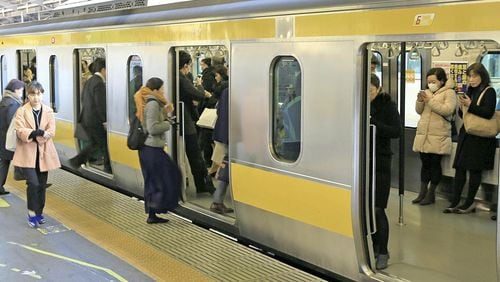TOKYO - Thirty years after their introduction, it will soon be the end of the line for seat-free trains in the Tokyo metropolitan area.
The trains, which have seats that can be folded up to provide more standing room during rush hour, will be phased out by 2020 because new lines that started operating in recent years have eased commuter congestion and the carriage doors do not align with standard platform-edge doors.
Just after 8 a.m. on a weekday morning in late January, a company employee in his 50s got off a JR Chuo-Sobu Line seat-free train at JR Shinjuku Station in Tokyo. "I'm used to these trains, but it's a pain when the train is empty and I can't sit down," he said with a wry smile.
According to East Japan Railway Co. (JR East), the standing-only cars were introduced on the Yamanote Line in 1990. The fold-up seats were installed in two of the train's 11 cars. Another distinguishing feature was these cars had six doors on each side, rather than the usual four, to make getting on and off easier.
Though there were complaints that these trains were inconvenient for elderly people and families with small children, the number of cars with fold-up seats peaked at 308 on five JR lines in fiscal 2006. The Tokyu Denentoshi Line also introduced the cars in 2005.
However, JR's Yamanote, Yokohama, Keihin-Tohoku and Saikyo lines had all stopped using the cars by August 2014. In May this year, the Tokyu Denentoshi Line will finish using the fold-up seats in its trains.
The Chuo-Sobu Line still operates these cars, but a JR East official said, "We'll replace them with different cars by the spring of 2020."
The easing of in-train congestion is the biggest reason behind the disappearance of the seat-free cars.
This decline is largely the result of the capital's train network having an increased capacity due to the opening of the JR Shonan-Shinjuku Line, the Tokyo Metro's Fukutoshin Line and other lines in recent years.
Another factor behind the demise of the seat-free cars is their six doors do not align with standard platform-edge barriers, which are designed to line up with four-door cars. The transport ministry has called on railway operators to quickly install these platform barriers, especially at stations used by many commuters.
"The seat-free cars were effective at a time when rush hours were so congested, but they've finished their role in society," said Fumihiko Nakamura, vice president at Yokohama National University and an expert in urban transportation planning. "I think future improvements to train cars will make them more comfortable, rather than more practical."






